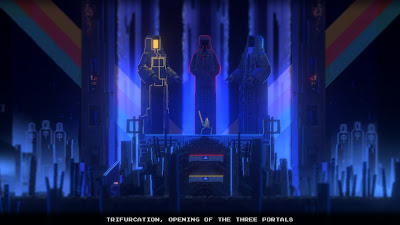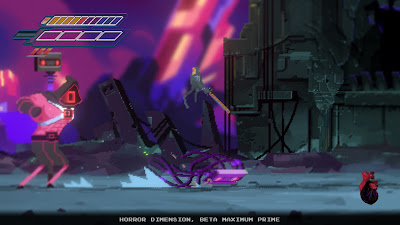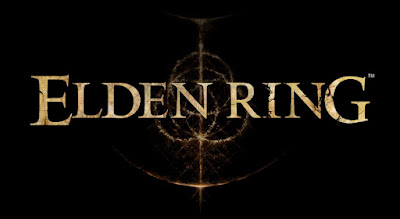[contains minor spoilers]
Undeniable is the passion that drips from Narita Boy's pixelated pores. It's a game designed by an artist, painting a vibrant and cautionary tale of obsession, ostracism, and the value of family. While screenshots of it are stunning, in motion it's a categorical wonder. And I'd heap even more praise atop Narita Boy's pedestal... if not for the fact that as a video game, it's a fairly troubled product. It straddles the line between "okay" and "mediocre", unsure if it should be a metroidvania, scenic platformer, or battle-focused brawler. Narita Boy is an easy game to suggest a trailer for, but a hard game to recommend a playthrough of.
First off, I can't make heads or tails over whether I enjoyed Narita Boy's story or not. Early on, you'll be subjected to massive blocks of text from NPCs—and that never really lets up. Worse yet is most of the dialogue is jargon-heavy, tossing out proper nouns like the first draft of a fantasy novel. Reading gradually turns into a chore as directives and backstories are frequently interwoven, utilizing so much programming language that you're never really certain what the hell it is you're supposed to be doing. At the best of times there will be a modicum of cogency, but at the worst of times you'd be better off interpreting it high on acid.
Yet there's a beauty and subtly to Narita Boy, one I didn't expect given its cartoonish opening. Narita Boy's story opens by emulating Tron but unfolds closer to Ready Player One, using the digital world as a means to detail the life of its lauded-yet-troubled creator. You'll learn about his childhood, early trauma, favorite hobbies, and the emotional ties to his family. It's quite touching at parts (in no small part due to the pensive music), hiding a lot of gorgeous detail in each of the vignettes you unlock. Plus it provides a nice, humanistic reprieve from the silly digital people and their all-too-videogamey problems.
However, Narita Boy fails to stick its landing in a graceful manner, opting to read too literally for my tastes. The central villain—the black and crimson cloaked HIM—doesn't merely represent a digitized malice born from the creator's darker inclinations; HIM can physically enter the real world and plans to do so in order to subjugate all of humanity. It's a bizarre motive that shifts the narrative away from how trauma can fracture one's reality, leaning heavily into a juvenile, tokusatsu-esque goal of "save the world from the bad guy." It's a little hard to describe if you haven't played Narita Boy, but it effectively takes the interior struggle of the creator and morphs it into an external threat, transforming HIM from a personal villain into some faceless, unnuanced evil.
Additionally, central to Narita Boy is the poignant theme of a mother's love and guidance—something nice to see in a medium dominated by sad-dads. I thought it was a good twist too, given that the game starts with Narita Boy's mother stereotypically nagging him to stop playing video games and go to bed. But as the story continues, the theme really only extends to the creator's mother—and even then, her guidance is somewhat muddied by prophecy. At its end, Narita Boy re-emphasizes the love of the creator's mother while callously discarding the titular character's own mother (while she's injured no less!) in favor of teasing a genre-shifting sequel. Similar to the HIM development, it just goes to show how Narita Boy prioritizes being epic over being meaningful.
While the story didn't come together in a way I had hoped for, the visuals absolutely blew me away. Seriously, seeing how many frames of animation are contained not just within Narita Boy but each of the enemies and all of the background NPCs is mind-blowing, especially given how you only see a big chunk of the world once. Encounters like Black Rainbow, White Noise, and the final boss are a wonder to behold, and if there's one reason I'd have for recommending Narita Boy, it'd be to marvel at the game's fluid, playful artistry. The music is also appropriately moody during exploration but goes hard on the synths when the action picks up, fitting the game's aesthetic nicely.
Would that I could say the same about the gameplay, but that's where Narita Boy stumbles the most. Exploring the world is a confusing, bewildering mess until you understand that you're either doing one of two things: remembering where locked doors are or hunting down colored passcodes. Narita Boy is structured like a metroidvania, doling out traversal-boosting powerups and frequently requiring backtracking, but its progression is entirely linear, blocking access to earlier sections once you've completed them. It's not as annoying as it sounds however, as there aren't any health, energy, or damage upgrades; as soon as you pick up the trichroma sword, you'll have everything you need to beat the game. So Narita Boy gets the worst of both worlds: it's tediously sprawling while simultaneously lacking a gameplay motive to explore.
Likewise, combat is also a disorganized mess that takes some getting used to. By the end you'll have a variety of ways to engage your opponents, but since attacks have little-to-no animation canceling, expect to be doing hit and runs for the most part. Narita Boy also slides around like his shoes are coated in butter, so expect to occasionally collide with enemies and slip off ledges. Your sword comes with a nifty little shotgun blast but it shares the ammo with the laser beam (your most powerful attack by far), so you won't really be using it outside of an accidental finger slip. And there's plenty more to whinge about: the charge attack can only be done after a standing swipe, the shoulder bash is ineffective on most foes, the dodge button sends you backwards—but the thing that gets me the most is that you don't heal between fights. Instead you have to consume precious energy to recover one pip at a time... or you can die and restart nearby with full health. Why? Why make me spend five seconds killing myself at the start of every lengthy encounter? Why not at least heal me after boss fights, or save the "no healing" for a harder mode?
While Narita Boy boasts a healthy variety of enemies, almost all of them come with bloated HP values. Later on you'll get the ability to do more damage if you match your color to theirs, which carries the downside of same-colored foes doing more damage to you as well. I actually quite like this gamble, but sadly only a handful encounters encourage this buffing system. Some battles will simply have you switching to one color and dispatching the most annoying (ie tankiest) foe with a laser shot, while other battles won't use the dynamic at all, forcing you to whittle down enemies one inefficient stab at a time. There's a couple of decent gauntlets at the end of the game that push you to switch often and quickly, but by then it's too little too late.
There's plenty to like about Narita Boy—but there's also a hell of a lot that feels off. It's ultimately a hyper-polished amateur project, having the creative chops of an indie gem that's been unfortunately stuffed into the sloppy body of a late 2000's Newgrounds game. Perhaps it needed a few more programmers, or a larger playtesting pool, or a bit more time in development—or maybe this is exactly the game Studio Koba wanted to make, warts and all. They're clearly a talented developer that poured a lot of manpower and sweat into their product, which is why I feel so down on disliking it. Narita Boy at least put Studio Koba on my radar... but I'll likely be going into their next title with warranted skepticism.













